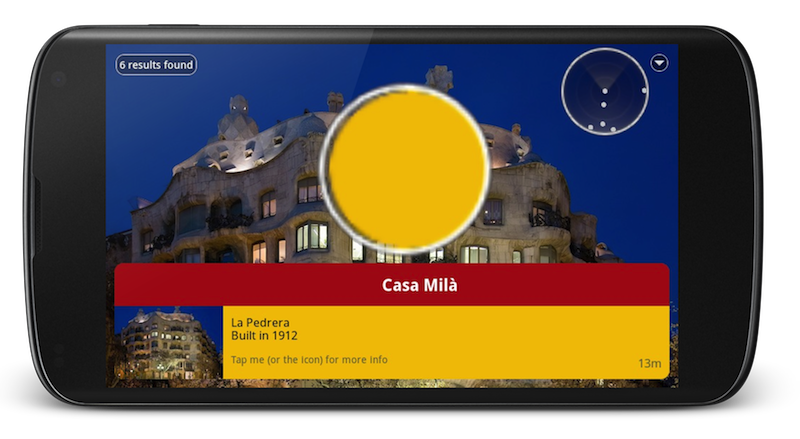- February 27, 2013
- Joe
- knowledge
- 2 Comments
Last week Metaio announced with great -and justified- fanfare the first AR Engine. This engine is going to be manufactured in tandem with ST-Ericsson. So, what is it all about?
Let it be said that we -obviously- embrace and welcome any advantages in the AR world. The more improvements, the better. Indeed Metaio and ST-Ericsson should be proud of their development, is certainly innovative. That being said, lets look at this more closely.
AR workings 101
As we have said several times, AR is mainly divided between geo and image based. Long history short, image based triggers the AR by scanning an image with a camera, where as GEO is triggered by geographic position. Needles to say both show the result on the devices screen.
Up until this moment, AR requires great CPU power and almost uses all the main components in a cellular phone. For example:

On the above image, we can appreciate AR in action. The big yellow dot is where Casa Mila is, telling us that it was built in 1912, is 13m from where the person (phone) is, and on the top left corner, an small summary (via radar view) of the surrounding points of interest the person has close by.
How does this happens?
The distance is obtained from the GPS, the graphics are overlaid and calculated by the graphics accelerator on the phone, the live image is being feed by the camera, the data (name and location of Casa Mila) was fetch from the cell network (by way of using the cellular radio) and last but not least, the CPU assembles the puzzle together. So, as you can appreciate, using AR demands the use and power of the main components on a mobile device.
The previous was for GEO based AR, in the case of image based AR, except the GPS, everything else is also being used.
We can see the big limitation, in the sense that, to enjoy AR, an app has to be manually executed in order for the magic to happen. It wasn’t practical -while possible- to have AR active on the background, it would have drained the battery very fast, something that any phone user would not have liked at all.
AR Engine
All these shortcomings are the ones that the Metaio AR Engine is trying to address, by -mainly- putting the image recognition on hardware instead of software. Imitating the functionality of the graphic card, an AR app (or the OS itself) can request recognition to the chip, freeing the CPU to do such a thing. Operating this way will -hopefully- be more energy efficient, as only “one?” chip on the circuit has to be active to execute the image recognition, making it faster and -again- enabling the possibility of having AR always active in the background, more or less the way location in our phones works: Location its not always active, but when it is, it’s fairly fast to get it up and running. The chip could potentially enable the phone camera to be always active, however without needing the camera itself to take the same amount of power, as the image its not meant to be shown right away, it might analyzed in the background by this chip.
Now, this is what Metaio is telling the world. Hopefully this engine will accelerate image recognition, or -even better- improve it, in the sense that’s more flexible. But its unclear if the current limitations on image recognitions will be addressed. For those unaware of it, in order for an image to be used as an AR trigger, this image should be: high in contrasts, with no patterns, sharp (no blur) and avoid monochrome. The previous limitations, are ones on the recognition algorithms themselves. More or less, every AR image recognition system has the same limitations. So, putting this on a chip (engine), only can make it faster, however that doesn’t mean it will -or can- be more flexible.
Deployment
Of course, ST-Ericsson will offer this on their mobile platform. The biggest customer for ST-Erisson was NOKIA, however the big phone manufacturers like, Samsung, Sony (SonyEricsson, in its past life), HTC, Motorola, etc. are not using ST-Ericsson mobile platform. Some of those manufacturers use the Qualcomm mobile platform, others build their own. So, in order for this AR chip to be in the hands of customers, a phone manufacturer has to commit to this new ST-Ericsson mobile platform. As of this writing, this is still unknown as the AR chip hopes to start appearing by the end of this year, or the beginning of the next one (2014), there’s still some time to figure this out for all the parties.
Qualcomm
Now the big white elephant in this room is Qualcomm. As it was explained before, AR requires a lot of power from the mobile device, and Qualcomm makes mobile device platforms. Hence it’s a no brainer that one of the biggest proponents of AR has been Qualcomm, as a matter of fact one of the most popular SDKs (competing with Metaio’s and others) for AR is Vuforia, made by Qualcomm. The company’s intentions are very clear: the more AR software is distributed, the more power it demands from the phones, the more the need for our powerful platform. It remains to be seen how Qualcomm will react (if any) to this announcement.
Qualcomm point of view might be that since their platform becomes more powerful and energy efficient day by day, such a chip (the AR one) its not necessary.
We’ll see, in any case this are extraordinary news for every one of us in the AR world.
